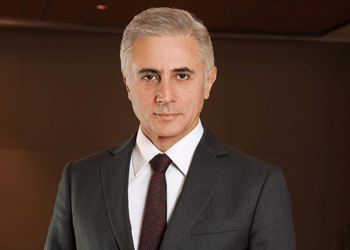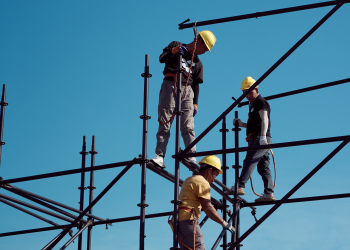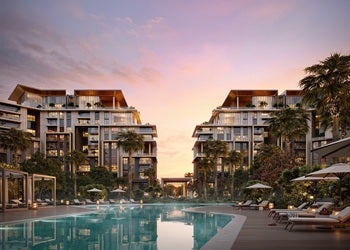PropTech sets out to transform built world
8 September 2022
PropTech has become a new buzzword in today’s highly digitalised world. The umbrella term for tech-driven innovative building industry solutions, its adoption is accelerating rapidly – rising by a staggering 1,072 per cent from 2015-19, according to Forbes.
Property technology is only poised to keep growing. A recent study by PwC and the Urban Land Institute highlighted that the use of technologies by real estate companies in Europe will trend upwards over the next three to five years.
Expedited further by the pandemic, property technology is reconfiguring how all stakeholders relate to the built environment, from how they experience, design, construct and market buildings to property management.
Outlined below are some important ways this unfolds across the five property development stages.
Digitalised cities
Data technology is the cornerstone of smart cities. Offering multiple sustainability benefits, it is being used to integrate building and infrastructure systems.
Sensors, data centres and digital twins monitor key historical and real-time indicators of demographic trends, property inventories, power and water use, and building carbon emissions. By using urban data analytics, policies for waste reduction, building decarbonisation and even affordable housing can be better achieved.
A prime example is Singapore’s pioneering digital twin experiment. Data in the form of GIS, lidar and satellite imagery were processed to create a 3D digital replica called ‘Virtual Singapore’.

A snapshot of Virtual Singapore, the city’s pioneering digital twin project. Source: National Mapping Archives – gwprime (geospatialworld.net)
The single, centralised, real-time database is already helping the city to respond to challenges related to water supply management, track real estate market changes, and deploy solar farms to meet growing domestic and industrial demands.
PropTech adoption accelerated by 1,072 per cent from 2015 to 2019
E-real estate
In the real estate sector, technology is helping to solve problems such as lack of transparency, information asymmetry and high investment risks. In the UAE, a person renting or buying property exclusively through a broker is almost unheard of, while 93 per cent of US buyers use real estate websites when searching for a home. This may mean the entire market is becoming digitalised.
And for very good reasons. For one, online sales platforms simplify the arduous task of property hunting for people with little background knowledge in a sophisticated and highly technical field. Platforms such as Bayut and RealAR app offer in-depth information on listing characteristics, provide analysis of comparable properties, and even furnish virtual simulations to help guide purchase and modification decisions.
But technology is poised to go even further. For example, price-gouging algorithms are being developed to use predictive analytics that process data on transactions, forecast future trends, value property returns and assess mortgage quotations, all aimed at oiling the wheels of a heavy-moving sector.
| Subscribe to MEED.com The #1 platform for business news and intelligence trusted by 1,000+ leading, global brands |
Building information management
BIM has sounded the death knell for the age of Computer-Aided Design (CAD). Architects and urban designers are now using advanced software to model multi-layered information instead of physical forms. By doing so, integrated design – so crucial for sustainable development – has become business-as-usual.
BIM allows professionals to design, modify and manage the building’s entire lifecycle using a single virtual model that simulates its performance. Further, using parametric tools, designers can even tweak design factors to meet priority sustainability targets.
This is how the National University of Singapore delivered its new School of Design and Environment. Using BIM technology, architects were able to explore options in massing and orientation, canopy and opening sizing, and room layouts by reporting their environment and energy performances in real time.
Optimising these, they passively minimised the building’s baseline energy and material demands. Then, a parity was struck by deploying renewable energy technologies such as 1,225 photovoltaic panels and hybrid cooling systems, allowing the university to pioneer the city’s first net-zero energy building.

The School of Design and Environment – Singapore’s first net-zero energy building. Source: NUS School of Design & Environment, SDE 4 – Surbana Jurong
3D construction
Technology’s introduction to construction is transforming the sector into a safer, wasteless, cost-effective and faster enterprise. One way this is happening is through innovations in 3D printing machinery. These use BIM models to digitally produce on-site or prefabricated components most efficiently, while complementary smart machinery robotically performs repetitive tasks like concrete pouring and plastering.
One notable example is Dubai Municipality’s largest 3D printed structure in the world, built in 2019. Standing 9 metres tall with an area of 640 square metres, the edifice employed only three workers.

Apis-Cor’s award-winning 3D-printed building, Dubai. Source: Apis Cor builds world’s largest 3D-printed building in Dubai (dezeen.com)
The breakthrough came in constructing the walls by a printer instead of the traditional wooden formwork, steel reinforcement and concrete pouring methods. This was complemented by precast slabs and prefabricated windows, which offered multiple cost and environmental savings.
Nonetheless, the extent of the scalability of 3D printing to multi-story residential and office buildings remains to be explored.
Technology is percolating and reforming every stage of the real estate value chain, from smarter cities to efficient building design, construction, operation and marketing
Green building management
Surprisingly, it has been reported that green-rated buildings can miss their performance and savings targets. According to a recent study, the primary cause is human behaviour. Either uninformed or disincentivised to take full custody of carefully-designed systems, end users frequently misuse them.
But technology has provided the solution: building management systems (BMS), through IoT or digital twins, can track parameters like energy and water usage, waste generation, carbon emissions and indoor air quality, and help to control them.
BMS can even compare performance to design metrics. This is demonstrated by the newly completed Beeah headquarters in the UAE. Acclaimed to be the first fully AI-integrated office in the Middle East, this LEED-certified smart building employs a digital twin as the basis for a Smart Facility Management System.
By learning occupancy habits, one novelty of this system is its ability to forecast energy demands and optimise electricity consumption, conduct predictive maintenance checks, and even take autonomous decisions to rectify faults in equipment performance, achieving a huge 90 per cent energy efficiency saving.

Zaha Hadid’s Beeah headquarters is futuristic in form and operation. Source: BEEAH Headquarters – Zaha Hadid Architects (zaha-hadid.com)
Although a relative laggard in digital transformation, the building sector is swiftly catching up. Technology is percolating and reforming every stage of the real estate value chain, from smarter cities to efficient building design, construction, operation and marketing.
By doing so, PropTech is helping to solve some of the sector’s perennial problems. It is improving information transparency, social inclusion, building design and residents’ wellbeing, in addition to reducing risk and limiting waste generation and carbon emissions, among many other benefits.

The views expressed are those of the author and do no necessarily reflect the company's position.
Exclusive from Meed
-
 June 2025: Data drives regional projects
June 2025: Data drives regional projects30 June 2025
-
 UAE-Turkiye financial links strengthen
UAE-Turkiye financial links strengthen30 June 2025
-

-
 Iraq approves Basra housing project
Iraq approves Basra housing project30 June 2025
-
 Meraas announces Dubai City Walk expansion
Meraas announces Dubai City Walk expansion30 June 2025
All of this is only 1% of what MEED.com has to offer
Subscribe now and unlock all the 153,671 articles on MEED.com
- All the latest news, data, and market intelligence across MENA at your fingerprints
- First-hand updates and inside information on projects, clients and competitors that matter to you
- 20 years' archive of information, data, and news for you to access at your convenience
- Strategize to succeed and minimise risks with timely analysis of current and future market trends

Related Articles
-
 June 2025: Data drives regional projects
June 2025: Data drives regional projects30 June 2025
Click here to download the PDF
Includes: Top 10 Global Contractors | Brent Spot Price | Construction output
To see previous issues of MEED Business Review, please click herehttps://image.digitalinsightresearch.in/uploads/NewsArticle/14171168/main.gif -
 UAE-Turkiye financial links strengthen
UAE-Turkiye financial links strengthen30 June 2025
 This package on UAE-Turkiye relations also includes:
This package on UAE-Turkiye relations also includes:> UAE-Turkiye trade gains momentum
> Turkiye’s Kalyon goes global

Turkish bank DenizBank is one of Turkiye’s leading private banks and, as a wholly owned subsidiary of Emirates NBD since 2019, it is playing a leading role in developing business links between the UAE and Turkiye.
Recep Bastug, who was appointed as DenizBank’s CEO in 2024, says there is great potential for trade between the two countries.
“Turkiye is a growing country,” he says. “We’ve had volatility over the past five years, but the Turkiye economy and the banking sector have been able to manage those periods successfully.”
Having spent years with international institutions such as BBVA, Bastug has vast experience in the banking sector. “Turkish banks, especially private ones like DenizBank, are very successful. In terms of capital, balance sheet structure and digital transformation, we are in a strong position,” he says.
 Solid fundamentals
Solid fundamentalsTurkiye’s fundamentals remain solid with a diversified export-oriented economy, a young and skilled population of 85 million, and relatively low debt levels. “We are not a highly leveraged country. Our household debt-to-GDP ratio is low. With the right policy mix, we offer high potential for foreign investors,” says Bastug.
That potential is increasingly being realised through growing engagement with the GCC and the UAE. “Turkiye’s connection with the Gulf is going up, and DenizBank is set to play a serious role in these relations. Day by day, Turkish companies are expanding their footprint in the region.”
GCC projects
Baştug says that many of these companies approach DenizBank to help facilitate their entry into Gulf markets. “Some of our clients are extremely well capitalised, but others need support for major projects. Just recently, one Turkish company announced a $3bn project in the region. We’re helping them connect with Emirates NBD and navigate the local financial landscape.”
DenizBank is actively supporting the creation of trilateral partnerships – particularly between Turkiye, the UAE and Saudi Arabia. “We see huge opportunity in forming financial strongholds across these markets, leveraging Turkiye’s contractor experience, the UAE’s capital and Saudi Arabia’s scale,” says Baştug.
DenizBank is already delivering results. “With Emirates NBD, we’ve identified 10 strategic cooperation areas, including trade finance, payments and capital markets. Thanks to this partnership, Emirates NBD has become the number one debt capital markets bank in Turkiye, even ahead of global players.”
One area of growing activity is initial public offering (IPO) participation. “We’ve launched a mutual fund that allows Turkish private banking clients to participate in IPOs from the region, including from the UAE and Saudi Arabia. It’s a diversification strategy and helps retain wealth within the group.”
Turkiye’s connection with the Gulf is going up, and DenizBank is set to play a serious role in these relations. Day by day, Turkish companies are expanding their footprint in the region
Recep Bastug, DenizBankInflation ends
Despite the current inflationary environment, Bastug says there is a clear inflection point ahead. “We expect 2027 to be a turning point. Once we exit the inflationary accounting regime [in Turkiye], DenizBank will become one of the biggest contributors to Emirates NBD’s global balance sheet. Last year, we contributed $1.2bn. In 2027, it will be significantly more.”
DenizBank is the fifth-largest private bank in Turkiye with about a 5% market share. “The largest private bank is at 13%. It’s not easy to close that gap – but we will do it. Our long-term goal, aligned with our shareholder, is to become the biggest and most successful private bank in the country.”
The bank is especially focused on agriculture, SMEs, and export financing – sectors that are deeply relevant to
Turkiye’s economic growth and to regional demand. “We are the leading agricultural bank in Turkiye, and we believe strongly in the sector’s future – both for local consumption and exports.”Regional opportunities
Bastug also sees potential for engagement beyond the GCC, including in post-conflict reconstruction. “In the past, Turkiye had strong trade volumes with Syria. Even during wartime, commercial links remained. Once a stable environment emerges, there will be opportunities – especially in infrastructure.”
While a physical branch presence is not currently being considered, DenizBank is prepared to support Turkish contractors operating in neighbouring countries. “We have the relationships and expertise to facilitate this growth. And culturally, we’re well aligned with the region – it helps make business smoother.”
As Turkiye re-establishes economic momentum and Gulf economies look to deliver on long-term visions, DenizBank is positioning itself for a more active role in the region in the future. “We are preparing the bank for the next stage, and with the backing of Emirates NBD, we’re confident in our ability to lead.”
READ MORE
> UAE-Turkiye trade gains momentum
> Turkiye’s Kalyon goes globalhttps://image.digitalinsightresearch.in/uploads/NewsArticle/14170372/main.gif -
 Multiply agrees to sell Pal Cooling to Tabreed and CVC
Multiply agrees to sell Pal Cooling to Tabreed and CVC30 June 2025
Abu Dhabi-based investment company Multiply Group has agreed to sell all of its shares in its district cooling subsidiary Pal Cooling Holding (PCH) for AED3.8bn ($1bn) to a consortium comprising Engie-backed National Central Cooling Company (Tabreed) and CVC DIF.
The transaction is still subject to regulatory approvals.
MEED exclusively reported in May that a team comprising Tabreed and CVC was holding exclusive discussions to acquire PCH.
Multiply Group initially acquired a 100% stake in PCH and its subsidiaries in July 2021.
Multiply Group has been advised by Standard Chartered and Clifford Chance. Tabreed and CVC DIF have been advised by Citi, Synergy Consulting and White & Case.
The transaction brings together two of the UAE’s leading district cooling players. PCH was founded in 2006 and operates five active district cooling plants across the UAE. The company maintains eight long-term concessions and strategic partnerships with some of the UAE’s leading real estate developers, servicing key residential, commercial and mixed-use developments – most notably on Abu Dhabi’s Reem Island.
Tabreed owns and operates 92 plants, including 76 in the UAE, five in Saudi Arabia, eight in Oman, one in Bahrain, one in India and one in Egypt, in addition to other international projects and operations.
https://image.digitalinsightresearch.in/uploads/NewsArticle/14170511/main.jpg -
 Iraq approves Basra housing project
Iraq approves Basra housing project30 June 2025
Iraq has approved plans to build a housing project in Basra that will offer about 5,000 homes in the first phase to tackle the country’s rising housing shortage.
The project, which is endorsed by Iraq’s National Investment Commission (NIC), will cover an area of about 3 square kilometres.
According to local media reports, Basra province governor Asaad Al-Idani said the project has already been awarded to a developer.
Iraq has been gradually recovering since the war. The government initially prioritised infrastructure and public housing to stimulate economic growth, improve living standards and attract foreign investment.
More recently, benefitting from higher oil prices and a period of relatively stable governance, Baghdad has expanded its focus to reconstructing and modernising the country’s deteriorating infrastructure.
The Iraqi construction market has also seen significant investments from private real estate developers from the region. In May, Egyptian real estate developer Ora Developers announced that it had started construction on the Al-Wardi residential city project, which consists of more than 100,000 residential units covering about 61 million square metres (sq m) on the southeastern side of Baghdad.
The move is the latest sign of international investors’ growing appetite for developing real estate in Iraq as part of the country’s post-war building initiatives.
Also in May, another Egyptian firm, Talaat Moustafa Group Holding, said it was in negotiations with the NIC to develop a mixed-use project. The project, which will cover an area of about 14 million sq m and will be located in the southwest of Baghdad, is expected to contain about 45,000 residential units.
The positive sentiment has been particularly buoyed by a robust 2024 budget, which allocated nearly $42bn to transport, social infrastructure and housing initiatives.
Looking ahead, Iraq’s construction industry is expected to register an annual average growth rate of 4.9% in 2025-28, supported by further investments in energy, infrastructure and housing projects, according to UK analytics firm GlobalData.
MEED’s June 2025 report on Iraq includes:
> COMMENT: Iraq maintains its pace, for now
> GOVERNMENT & ECONOMY: Iraq’s economy faces brewing storm
> OIL & GAS: Iraqi energy project value hits decade-high level
> PIPELINES: Revival of Syrian oil export route could benefit Iraq
> POWER: Iraq power sector turns a page
> CONSTRUCTION: Iraq pours billions into housing and infrastructure projects
> DATABANK: Iraq forecast dips on lower oil priceshttps://image.digitalinsightresearch.in/uploads/NewsArticle/14170011/main.png -
 Meraas announces Dubai City Walk expansion
Meraas announces Dubai City Walk expansion30 June 2025
Register for MEED’s 14-day trial access
Local real estate developer Meraas has announced the City Walk Crestlane project as it continues to expand its City Walk residential community in the Al-Wasl area of Dubai.
The City Walk Crestlane comprises two residential towers offering 198 one-, two-, three-, four- and five-bedroom units.
The project is expected to be completed and handed over by the third quarter of 2028.
Earlier this month, Meraas, which is part of Dubai Holding Real Estate, awarded a construction contract for another project at City Walk.
The local firm Naresco Contracting was awarded a AED450m ($123m) contract for the main construction works on its Central Park Plaza residential project at City Walk.
The project involves constructing two towers with 23 and 20 floors. Together, they will have 212 residential units.
In May, Meraas awarded another local firm, Al-Sahel Contracting Company, a AED300m contract for the main construction works on Elara, which is phase seven of the Madinat Jumeirah Living masterplan in Dubai.
The project involves building three residential towers with 234 apartments.
https://image.digitalinsightresearch.in/uploads/NewsArticle/14169472/main.jpg

